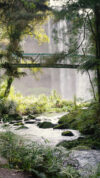Alle Downloads der Kategorie
Vallon et al. (2018) Focal Species Candidates for Pesticide Risk Assessment in European Rice Fields: A Review
An assessment of potential risks of pesticides on wildlife is required during the process of product registration within Europe because of the importance of agricultural landscapes as wildlife habitats. Despite their peculiarity and their specific role as artificial wetlands, rice paddies are to date pooled with cereals in guidance documents on how to conduct risk assessments for birds and mammals in Europe.
Gradish et al. (2018) Comparison of Pesticide Exposure in Honey Bees (Hymenoptera: Apidae) and Bumble Bees (Hymenoptera: Apidae): Implications for Risk Assessments
To date, regulatory pesticide risk assessments have relied on the honey bee (Apis mellifera L.) (Hymenoptera: Apidae) as a surrogate test species for estimating the risk of pesticide exposure to all bee species. However, honey bees and non-Apis bees may differ in their susceptibility and exposure to pesticides.
Alscher, Hecht-Rost, Lückmann (2017) On the way to a new guideline: Results of three years of bumble bee semi-field testing
According to the EFSA Guidance Document on bees (EFSA, 2013), not only honey bees but also bumble bees should be considered in the risk assessment of plant protection products. Up to now, no official guideline for standardised semi-field trials is available to assess effects on bumble bees.
Blanckenhagen (2017) Enclosure set up: a well-known system as a new semi-field approach for risk assessment of plant protection products on common voles
Within the EFSA (2009) guided registration of pesticides, the risk assessment for small herbivorous mammals is an all-crop scenario, which often fails to reach the trigger indicating a safe use, even with the higher tier approach. For supporting ‘weight of evidence’ approaches, EFSA (2009) recommends field effect studies or population modelling.
Neuwoehner (2017) Chances and Challenges in Regulatory Ecotoxicological Mixture Toxicity Assessment for Plant Protection Products
Lückmann et al. (2017) Fenoxycarb, a suitable reference item in semi-field testing on the solitary bee Osmia bicornis (L., 1758) (Hymenoptera, Megachilidae)?
According to the ‘EFSA Guidance Document on the risk assessment of plant protection on bees’, not only honeybees but also bumble bees and solitary bees have to be considered for the first time. But for testing of solitary bees under laboratory, semi-field and field conditions no official test guideline exists.
Jakoby et al. (2017) Evaluating Ecological Recovery in Mechanistic Effect Models for Environmental Risk Assessment
In environmental risk assessments (ERA) for plant protection products (PPP) one possible protection goal option at the population level is recovery (EFSA, 2016). This recovery option accepts “some population-level effects of a potential stressor if recovery takes place within an accepted time period”.
Ludwigs et al. (2016) Appropriate Exposure Estimates for Wildlife Risk Assessments of Crop Protection Products Based on Continuous Radio Telemetry: A Case Study with Woodpegions
The registration of pesticides follows guidance published by the European Food Safety Authority (EFSA). As a default, the EFSA guidance document on risk assessment for birds and mammals assumes that animals feed exclusively on pesticide-treated fields.
Lückmann, Ludwigs, Delgado-Cartay (2015) Non-target organisms – higher-tier methods to refine the risk of plant protection products
Ludwigs et al. (2015) A statistical approach for selecting the most appropriate PT value for long-term wildlife risk assessments
In higher tier Risk Assessments (RAs) for Birds and Mammals, exposure takes into account the ‘portion of food taken from the treated area’, addressed by the surrogate parameter portion of time spent by birds or mammals potentially foraging in treated fields (the so-called PT value).
Nickisch, Krömer (2015) A standardised approach to identify worst-case FOCUS surface water exposure profiles in aquatic pulsed exposure events
The outcome of Tier 1 risk assessment for plant protection products frequently calls for the use of higher tier approaches to evidence an acceptable risk to aquatic organisms. In this context, laboratory pulsed exposure experiments can be used to test the effects of varying exposure concentrations on the mortality and/or immobilization of organisms.
Körner et al. (2014) Insecticidal activity of a PPP as a criterion to trigger laboratory studies with non‐Apis bees? Make a BeeCision!
Over the last six years, the effects of plant protection products (PPP) on pollinators such as honeybees have come increasingly to the attention of both scientists and the general public. In 2013, under the new EU Regulation 1107/2009, the European Food Safety Agency (EFSA) published a preliminary new guidance document (GD) on risk assessment for pollinators.


